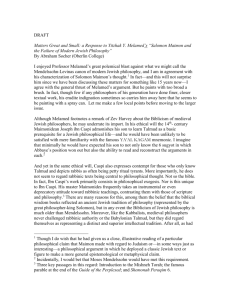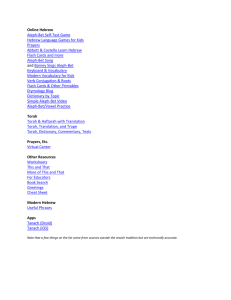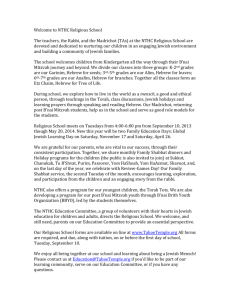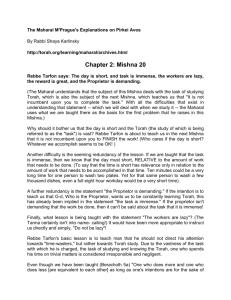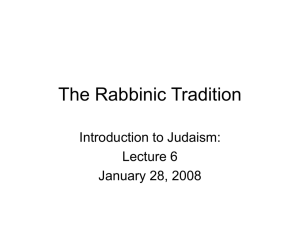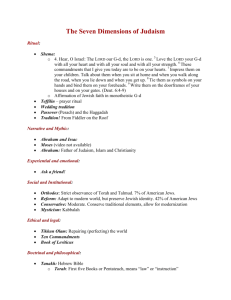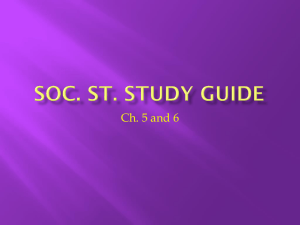The Teaching of Rabbinic Literature at a Reform Jewish Day School
advertisement
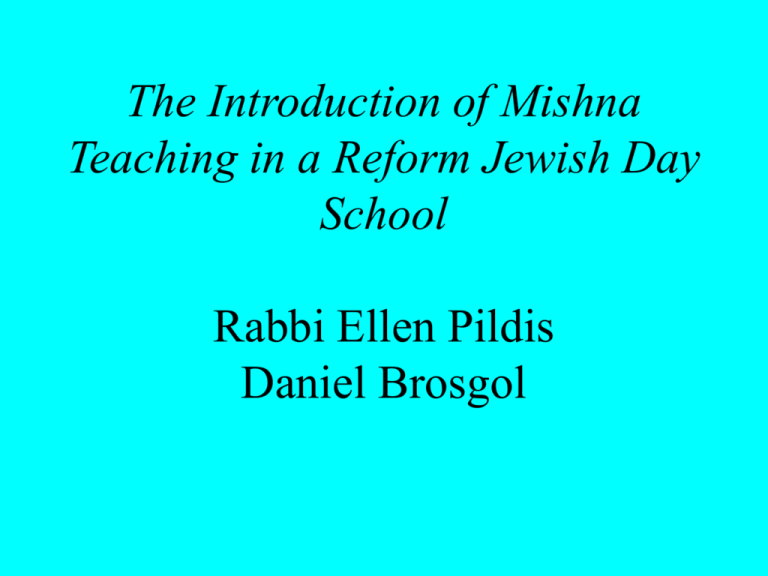
The Introduction of Mishna Teaching in a Reform Jewish Day School Rabbi Ellen Pildis Daniel Brosgol This presentation will examine the experience of introducing a curriculum for the study of Rabbinic literature for the first time at a Reform Jewish day school. What were the expectations of students, teachers, and families? What were the particular strengths and weaknesses of the students as they grappled with material? How did their previous work in Jewish studies prepare them for the study of Rabbinic literature? Based on teaching journals and the responses of the students and families, the presentation will discuss the challenges and successes of this first attempt at bringing Mishna to students at the school. How was the elective introduced? Dear Middle School Parents; Our community prides itself on the questions our students ask and on their ability to think independently. For centuries, the Jewish people have been questioning, thinking and re-thinking. We are excited to offer a special opportunity this year for interested students to learn Talmud. Learning Talmud provides us insight into the history and though processes of our people. We have chosen to use a program provided by Bonayich Educational Services that has recently been developed in Israel. The program represents a serious step forward in Jewish educational materials, providing quality materials for the student, and comprehensive aids for the teacher in skills instruction. The student materials include student activity books and audio disks, and the teacher materials include fully detailed teacher manuals, teaching aids, posters, etc. In addition, there is an interactive internet site called www.mishnahkids.com which provides a great avenue for review and enrichment. The class will meet two times per week and will be taught by Dan Brosgol. Students will not be graded on this- it will totally be Torah L’shmah-learning Torah just to learn! We hope to begin studying after the holidays and continue throughout the year. Please let us know if your child is interested! Once you have signaled your interest, we will work with families to find a time slot that works for as many students as possible. Goals • Students will be exposed, in an organized form, to Rabbinic literature, specifically Mishna. • Students will understand that midrash is a genre of Rabbinic literature. • Students will make connections between modern Hebrew and Rabbinic texts. Who are the students? The number has fluctuated during the year, but there is a core group of 10-12 students from grades six and seven that come on a regular basis. Most impressive is the fact that the students have chosen to give up their recess and lunch time to take the Mishna elective, and that they are willing to come twice a week. Judaic backgrounds of the students -Most have been at Rashi since Kindergarten -Newton Center Minyan (Conservative-style) -Beth El Temple Center, Belmont (Reform) -Temple Aliyah, Needham (Conservative) -Hillel B’nei Torah, West Roxbury (Reconstructionist) -Temple Emanuel, Newton (Conservative) -Temple Beth Elohim, Wellesley (Reform) -Temple Emeth ,Chestnut Hill (Conservative) What were the strengths of the students? 1. Strong family support for additional academic work 2. Above-average Hebrew skills compared to most students at Rashi 3. Families committed to Jewish learning 4. Willingness to explore something new What were the weaknesses of the students? -Students were not familiar with the terms “Torah she’bichtav” and “Torah shebe’al peh” and the curriculum assumed an understanding. -Students did not understand what the Mishna or the Talmud was. -Students were not familiar with terms like makhloket, masechet, seder, midrash, or aggadah. What were the weaknesses of the students? (continued) -Students were not familiar with any of the Tanna’im or Nasi’im. -Students did not know any of the place names and locations of the academies. What is the educational focus? • Shinun- memory learning/memorization by repetition and chanting • History- the redacting of the Mishna • Vocabulary- Rabbinic Hebrew and new phrases and words, i.e. netz ha-chamah What is happening in the classroom? • It is an active learning environment- talking, chanting, arguing, discussing. • Students enjoy the challenge of shinun. • Students are beginning to get an understanding of different Rabbis and their opinions and styles. How has the community responded? • Surprisingly, no one is questioning the curriculum. • Is this because the families don’t know the right kinds of questions to ask? • Is this because the families who are opting out of the elective don’t care? • Is this because the families who support this undertaking are simply happy that their children are beginning to learn some Rabbinic literature? Student survey questions • Why did you choose to take the Mishna elective? • What synagogue or minyan do you belong to or attend? • What has been the biggest challenge for you in studying Mishna? • How has your Rashi education prepared you for the study of Mishna? • What are the most interesting things about the Mishna elective? “Why did you choose to take the Mishna elective? “My friends were taking it.” “To learn Mishna.” “It sounded fun.” “My mom wanted me to.” What has been the biggest challenge for you in learning Mishna? -Memorizing (almost all students wrote this) -Chanting -Hebrew What has been the most interesting part of learning Mishna? “Learning the different opinions of the Rabbis.” “Reading and learning Mishna.” “Controversy.” “Discussions.” “Memorizing the mishnayot.” Beginning the program in the Fourth Grade A similar e-mail was sent out to Fourth Grade parents. A group of 10-12 students is now meeting at lunch to begin the study of Mishna. Parent response #1 From mother M Hi Dan, Today when E arrived home she was full of excitement and brimming with details about today's introduction to Talmud class. She was delighted that so many kids came and that there was great representation from each class. She was engaged in the material and the ability to ask questions to a teacher who thoughtfully answered. She is still mulling over how we define oral stories when they are actually written down! M Parent response #2 From mother A Hi all, A attended the Talmud class today at recess and at lunch. He enjoyed the class and told me a bit about what they talked about. It sounds like a wonderful program. I asked if he would continue to participate and he answered, “Yes, if my friends keep going, too.” So, I am appealing to you to encourage your kids to stay involved. It will be great to get the kids connecting with text and participating in stimulating discussions without the pressure of grades or tests. With this email list I have probably missed some of the kids who were there, or are interested in participating. Please send this along to anyone you think would want to see it. Thanks! A Parent response #3 From mother S “For them to come home and be able to say ‘Torah she-be’al peh’ was powerful for them.” (mother S) What have we learned? There is an interest in a Reform Jewish day school, from families with diverse backgrounds, to have more substantive learning in Rabbinics. There is a need to provide a stronger foundation in basic Rabbinic terms and concepts to our students to better prepare them for the study on Rabbinic literature. What have we learned? • Rashi students are excellent questioners and debaters. Rabbinic literature is a topic that engages them. • Rashi students are working to connect modern Hebrew to traditional texts.
